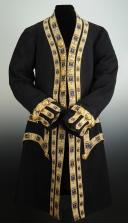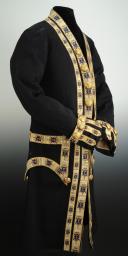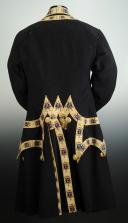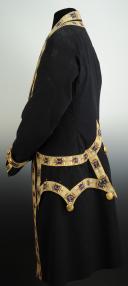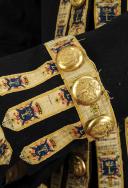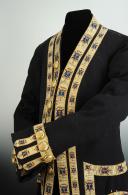
LIVERY UNIFORM BELONGING TO MARSHAL ADOLPHE NIEL, 1859-1869, Second Empire. 32280
LIVERY COAT OF MARSHAL ADOLPHE NIEL, 1859-1869, Second Empire. 32280
Coat made of national blue cloth bordered by two woven cotton threads with the arms of Marshal Adolphe NIEL. The outer braid is 30 mm wide, and the inner braid is 25 mm. These braids border the entire coat, at the collar, cuffs, pockets, and the waistcoat.
The style is "à la française." The coat closes on the chest with clasps sewn on the edges of the coat.
The buttons are gilded brass stamped with the Marshal's arms, measuring 31 mm in diameter. Six buttons are placed in the front - three on each cuff, two under each pocket, and two at the waistcoat.
Very good condition, wear on the braids.
France.
Second Empire (1859-1869).
COAT OF ARMS: Azure, with a golden L, topped with a nest containing three silver birds.
BIOGRAPHY:
Adolphe Jean Casimir Niel was born on the 12th day of Vendémiaire in the year XI1 into a bourgeois family that had been established in the Comminges county since the 17th century. His father, Joseph Niel, was a lawyer in the Parliament of Toulouse. Adolphe, a brilliant student, was admitted to the École Polytechnique in 1821 and then to the Metz application school in 1823.
In 1843, he married Clémence Maillères, the daughter of a customs receiver, at the Church of Saint-Laurent in Paris. They had two children: Amélie and Léopold.
Military Career:
Appointed as a Lieutenant in 1827, Niel was promoted to Captain in 1835. He sailed to Africa in 1836, attached to the engineering staff of the expedition against Constantine. Niel distinguished himself during the capture of Constantine, earning praise from the Minister of War. He was promoted to the rank of Colonel in 1846.
During the Italian expedition of 1849 behind General Oudinot, he served as the chief of staff of the engineering corps for the campaign in Rome. He had the honor of carrying the keys of Rome to the Pope in Gaeta.
Promoted to Brigadier General shortly after, he became a Divisional General in 1853. In 1854, he commanded the squadron that seized the fortress of Bomarsund during the Baltic Expedition. He was appointed as an aide-de-camp to Napoleon III upon his return in 1855.
Sent to Crimea, he directed the Siege of Sevastopol (1854-1855), leading to his appointment as the commander-in-chief of the engineering of the Eastern Army and the rank of Grand Cross in the Legion of Honour.
During the Italian Campaign, where he commanded the 4th Corps, he distinguished himself at the battles of Magenta and Solferino. In recognition of his military merits and strategic talents, Napoleon III elevated him to the rank of Marshal of France in 1859.
Appointed as Minister of War in 1867, succeeding Marshal Jacques Louis Randon, he initiated army reforms to modernize it despite opposition - known as the Niel Law, but he passed away before its completion. He notably established the Mobile Guard, created by the law of February 1, 1868. He provided infantrymen with the excellent Chassepot rifle.
Marshal Niel was nicknamed the Poliorcète.
He passed away in Paris in August 1869, following a surgical procedure necessitated by his worsening kidney disease, similar to that of the Emperor he had served so well. His funeral took place at the church of Les Invalides, with the hearse drawn by six horses driven by six liveried postilions, crossing Paris from the Ministry of War to Les Invalides. He rests alongside other family members at the Muret cemetery.
Coat made of national blue cloth bordered by two woven cotton threads with the arms of Marshal Adolphe NIEL. The outer braid is 30 mm wide, and the inner braid is 25 mm. These braids border the entire coat, at the collar, cuffs, pockets, and the waistcoat.
The style is "à la française." The coat closes on the chest with clasps sewn on the edges of the coat.
The buttons are gilded brass stamped with the Marshal's arms, measuring 31 mm in diameter. Six buttons are placed in the front - three on each cuff, two under each pocket, and two at the waistcoat.
Very good condition, wear on the braids.
France.
Second Empire (1859-1869).
COAT OF ARMS: Azure, with a golden L, topped with a nest containing three silver birds.
BIOGRAPHY:
Adolphe Jean Casimir Niel was born on the 12th day of Vendémiaire in the year XI1 into a bourgeois family that had been established in the Comminges county since the 17th century. His father, Joseph Niel, was a lawyer in the Parliament of Toulouse. Adolphe, a brilliant student, was admitted to the École Polytechnique in 1821 and then to the Metz application school in 1823.
In 1843, he married Clémence Maillères, the daughter of a customs receiver, at the Church of Saint-Laurent in Paris. They had two children: Amélie and Léopold.
Military Career:
Appointed as a Lieutenant in 1827, Niel was promoted to Captain in 1835. He sailed to Africa in 1836, attached to the engineering staff of the expedition against Constantine. Niel distinguished himself during the capture of Constantine, earning praise from the Minister of War. He was promoted to the rank of Colonel in 1846.
During the Italian expedition of 1849 behind General Oudinot, he served as the chief of staff of the engineering corps for the campaign in Rome. He had the honor of carrying the keys of Rome to the Pope in Gaeta.
Promoted to Brigadier General shortly after, he became a Divisional General in 1853. In 1854, he commanded the squadron that seized the fortress of Bomarsund during the Baltic Expedition. He was appointed as an aide-de-camp to Napoleon III upon his return in 1855.
Sent to Crimea, he directed the Siege of Sevastopol (1854-1855), leading to his appointment as the commander-in-chief of the engineering of the Eastern Army and the rank of Grand Cross in the Legion of Honour.
During the Italian Campaign, where he commanded the 4th Corps, he distinguished himself at the battles of Magenta and Solferino. In recognition of his military merits and strategic talents, Napoleon III elevated him to the rank of Marshal of France in 1859.
Appointed as Minister of War in 1867, succeeding Marshal Jacques Louis Randon, he initiated army reforms to modernize it despite opposition - known as the Niel Law, but he passed away before its completion. He notably established the Mobile Guard, created by the law of February 1, 1868. He provided infantrymen with the excellent Chassepot rifle.
Marshal Niel was nicknamed the Poliorcète.
He passed away in Paris in August 1869, following a surgical procedure necessitated by his worsening kidney disease, similar to that of the Emperor he had served so well. His funeral took place at the church of Les Invalides, with the hearse drawn by six horses driven by six liveried postilions, crossing Paris from the Ministry of War to Les Invalides. He rests alongside other family members at the Muret cemetery.
Price :
1 500,00 €
| Destination | Envoi recommandé | Envoi Recommandé + Express |
|---|---|---|
| Shipping France | 17,00 € | 50,00 € |
| Shipping Europe | 25,00 € | 70,00 € |
| Shipping world | 70,00 € | 120,00 € |
Insurance (1%) :
15,00 €
Reference :
32280 (3788-08)
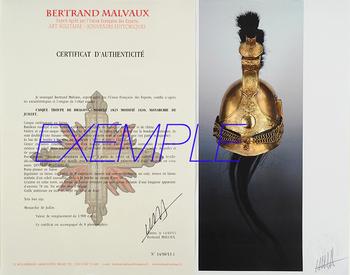
Next update Friday, june 20 at 13:30 PM
FOR ALL PURCHASES, PAYMENT IN MULTIPLE CHECKS POSSIBLE
bertrand.malvaux@wanadoo.fr 06 07 75 74 63
An authenticity certificate of the item including the description published on the site, the period, the sale price, accompanied by one or more color photographs is automatically provided for any item priced over 130 euros. Below this price, each certificate is charged 5 euros.
Only items sold by me are subject to an authenticity certificate, I do not provide any expert reports for items sold by third parties (colleagues or collectors).
